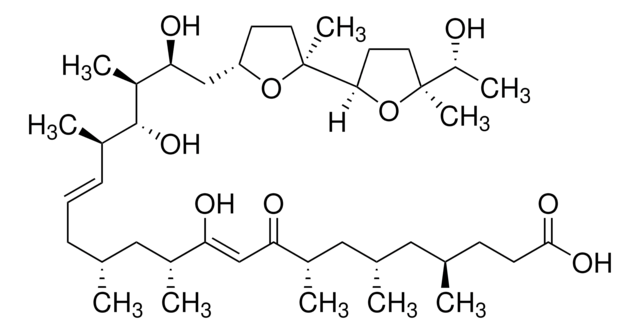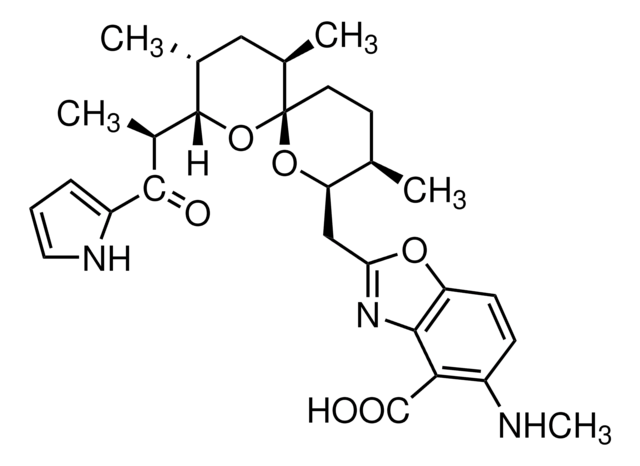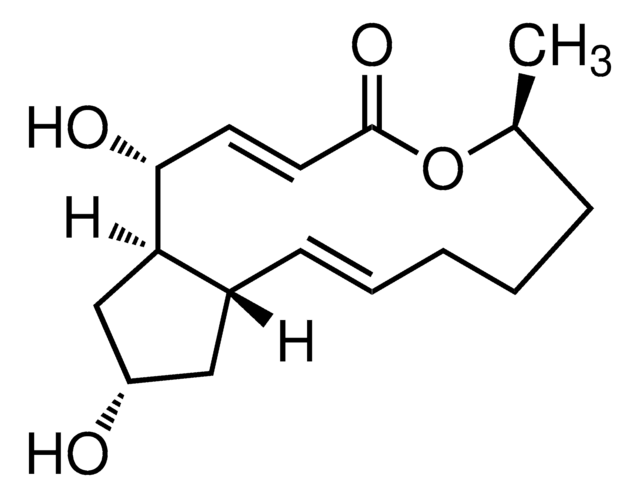524400
Phorbol-12-myristate-13-acetate
≥98% (HPLC), solid, PKC activator, Calbiochem®
Synonym(s):
Phorbol-12-myristate-13-acetate, PMA, TPA, PKC Activator I, TPA, PMA, PKC Activator I
About This Item
Recommended Products
product name
Phorbol-12-myristate-13-acetate, Phorbol-12-myristate-13-acetate, CAS 16561-29-8, is the most common phorbol ester. Activates PKC at nanomolar concentrations.
Quality Level
Assay
≥98% (HPLC)
form
solid
manufacturer/tradename
Calbiochem®
storage condition
OK to freeze
color
white
solubility
DMSO: 10 mg/mL
shipped in
ambient
storage temp.
−20°C
InChI
1S/C36H56O8/c1-7-8-9-10-11-12-13-14-15-16-17-18-29(39)43-32-24(3)35(42)27(30-33(5,6)36(30,32)44-25(4)38)20-26(22-37)21-34(41)28(35)19-23(2)31(34)40/h19-20,24,27-28,30,32,37,41-42H,7-18,21-22H2,1-6H3/t24-,27+,28-,30-,32-,34-,35-,36-/m1/s1
InChI key
PHEDXBVPIONUQT-RGYGYFBISA-N
General description
Biochem/physiol Actions
Protein Kinase C
Packaging
Warning
Preparation Note
Reconstitution
Other Notes
Tepper, C.G., et al. 1995. Proc. Natl. Acad. Sci. USA92, 8443.
Oishi, K., and Yamaguchi, M. 1994. J. Cell. Biochem. 55, 168.
Macfarlane, D.E., and O’Donnell, P.S. 1993. Leukemia7, 1846.
Ghandi, V.C. and Jones, D.J., 1992. Neuropharmacol.31, 1101.
Hortelano, S., et al. 1992. J. Biol. Chem. 267, 24937.
Kontny, E., et al. 1992. Eur. J. Pharmacol.227, 333.
Zanaboni, P.B., et al. 1992. J. Appl. Physiol.73, 2011.
Saltis, J., et al. 1991. J. Biol. Chem.266, 261.
Beguinot, L., et al. 1985. Proc. Natl. Acad. Sci. USA82, 2774.
Perchellet, J. 1985. Carcinogenesis6, 567.
Nishizuka, Y. 1984. Science255, 1365.
Mastro, A. 1982. Lymphokines6, 263.
Legal Information
Signal Word
Danger
Hazard Statements
Precautionary Statements
Hazard Classifications
Acute Tox. 1 Dermal - Acute Tox. 1 Inhalation - Acute Tox. 2 Oral - Carc. 2 - Eye Dam. 1 - Resp. Sens. 1 - Skin Corr. 1B - Skin Sens. 1
Storage Class Code
6.1A - Combustible acute toxic Cat. 1 and 2 / very toxic hazardous materials
WGK
WGK 3
Certificates of Analysis (COA)
Search for Certificates of Analysis (COA) by entering the products Lot/Batch Number. Lot and Batch Numbers can be found on a product’s label following the words ‘Lot’ or ‘Batch’.
Already Own This Product?
Find documentation for the products that you have recently purchased in the Document Library.
Customers Also Viewed
Our team of scientists has experience in all areas of research including Life Science, Material Science, Chemical Synthesis, Chromatography, Analytical and many others.
Contact Technical Service









